Which Of The Following Connector Types Would You Most Likely Use To Connect To A T1 Wan Service?

CAT6 is rated for gigabit Ethernet while CAT6e is thicker and rated for 10 gig Ethernet. Typically CAT5e is sufficient and can too handle gig Ethernet, simply noise margin will exist less.
Connector Types:
Fiber Connectors: The below figure shows the different fiber connector types .

1. ST connectors: These connectors are the most common blazon of commercial fiber optic connector. These connectors utilize an exposed plastic tube housing the optical fiber. This requires a connection to a matching cable on the other side, incorporating a connector that mates to the other. These combine in a bound-loaded twist, reminiscent of BNC connectors, and are noted for their reliability. ST connector is very popular in communication applications, such as LANs and CCTV systems.
ii. SC-Connector: SC is short for Subscriber Connect is 1 of the virtually frequently used connectors. Used in fiber-optic networking, it has caps to foreclose light amplification by stimulated emission of radiation light reaching eyes. The connector unremarkably in pairs (transmit and receive), often clipped together. connectors take the ferrule that houses the fiber more often than not curtained. Probably the virtually like commercial equivalent of To slink, SC connectors does not require a mating cable on the other side. Instead, these snap-on connectors but push into their jacks with a click. SC connectors utilize a push-pull design and can be used for simplex or multiplex applications
3. FC connector: It is similar to ST connectors, these fiber optic connector'southward screws into their mating jacks. Additionally, the tube surrounding the optical fiber is typically shrouded in ceramic or metal, as opposed to being fully exposed. The inner ring of the connector is keyed to ensure positive mating to its corresponding jack. FC connectors are primarily used with single mode fibers and used in telephone, instruments, and high-speed communication links. The way is similar to that of an ST connector, simply it uses a threaded connection which makes it meliorate suited for loftier vibration environments
iv. LC cables: latch and release into their jacks in a manner similar to Ethernet connectors. Smaller in form than SC connectors, their durability is not compromised, nor is cost increased. Instead of snapping or thermo forming the connector to the cable, it is glued. This makes it a popular connector for field use. LC connectors are used in individual and public networks, and are gaining in popularity due to their small form factor (SFF) optical transmitter/receiver assembly

LC connector is a miniaturized version of the cobweb-optic SC connector. It looks but similar the SC, but is half the size with a 1.25 mm ferrule instead of 2.5 mm. 1000BASE-FX should utilise SC, ST, LC, MTRJ or MIC connectors with SC being the preferred pick.
Usually, cable modems use F-blazon female connector to connect to the broadband provider.
ST (Short for Straight Tip) connectors, and SC (short for Subscriber Connect) connectors are typically big connectors. MT-RJ, and LC (curt for Local Connector) accept small grade factor, and allow higher port density. These connectors (MT-RJ and LC) permit college number of fiber optic connections in a smaller area, and hence desirable when there are a large number of fiber optic terminations to be fabricated.
Copper Connectors:
BNC- T connector: The effigy shows a BNC-T connector.
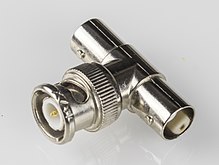
10BaseT and 100BaseT utilize RJ-45 type of connector. 10Base2 (also called Thinnet) uses BNC connectors for attaching workstations. BNC-T is used to connect a workstation to the Thinnet coaxial cable. The BNC-T(g) connector cease mates with the BNC(f) connector on the NIC card. The BNC-T(f) connector ends are attached to BNC(m) cables, that in turn attach to other computers through BNC-T connector. BNC connector is a co-axial connector, and used in 10Base2 networks.
BNC /Thinnet cable: 10Base2 network uses BNC cable as medium for physical transmission of electrical signals. The fig shown below is a BNC cable with male person connectors.

RJ-45 : The connector shown in the exhibit is RJ-45 connector.
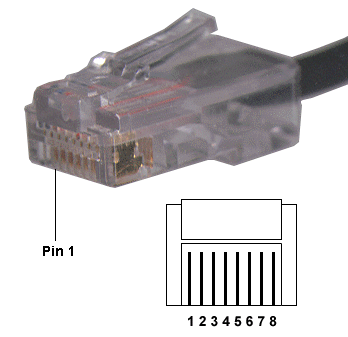
RJ-45 connector is the most normally used connector in 10BaseT, and 100BaseT networks. RJ-11 connectors are ordinarily available either with 4-wire or 6-wire, whereas RJ-45 has 8 wires (4-pairs). An RJ-45 connector has 8 connectedness pins and tin can accommodate 4 pairs of wires. Typically, a UTP cablevision with RJ-45 connectors is used to connect the NIC card on the home estimator with the DSL broadband modem. RJ-45 connectors accept 8 contacts. RJ-45 connector is virtually usually used in 10BaseT, and 100BaseT networks. RS-232 is a serial port specification. RJ-48C connectors are 8-pin jacks (think RJ-45) used with T1 lines. Pins 1, two, iv, and 5 are used for data (1 and two for receiving; iv and five for transmitting), and pins 7 and 8 are used for cable shield integrity. Pins iii and six are not used.
- RJ-11 (Registered Jack) connectors are pocket-size plastic connectors used on phone cables.
- RJ-45 connectors are used with twisted-pair cabling. RS-232 (Recommended Standard) is a TIA/EIA standard for serial transmission between computers and peripheral devices
- A mutual connection type used to connect to a CSU/DSU is an RJ-48C.
The connector shown in the exhibit is a iv-wire RJ-11 connector. RJ-11 connectors are as well bachelor in 6-wire.
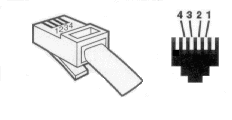
Two oft used Firewire connectors are 4-pin connector, and vi-pin connector. A four-pin connector does non comport power through the connector, whereas a half dozen-pin connector carries the dc-power required for operating the connected device.
Fiber eyes connector
MT-RJ (Mechanical Transfer Registered Jack): This uses a form cistron and latch like the RJ-45 connectors, supports full duplex. It costs less than ST or SC connectors, and is easier to terminate and install than ST or SC.
RS-232 (Recommended Standard) is a TIA/EIA standard for serial transmission betwixt computers and peripheral devices such as modems, mice, and keyboards. RS-232 commonly uses a 25-pin DB-25 connector or a 9-pivot DB-9 connector.
DB fifteen connector can be found on sound cards, older AUI network cards and devices, as well as legacy Macintosh monitors. This is commonly referenced as the Game port. This is due to the fact that the nigh common peripheral for this port was a joystick or video game controller.
DB 37 connector is used sometimes with Cisco networking hardware, and other applications that use RS-449 serial communication.
HD15 is a High Density DB-style connector, so information technology can as well be called an HD DB15. It is used in video applications that support much higher resolutions.
F-blazon connector: The exhibit shows an F-Connector. F-Connector is widely used in TV and Video displays
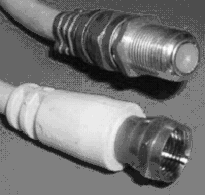
Copper termination standards
T568A and T568B are the 2 color codes used for wiring 8-position RJ45 modular plugs. Both are allowed under the ANSI/TIA/EIA wiring standards. The only divergence betwixt the two colour codes is that the orange and green pairs are interchanged.
TIA/Environmental impact assessment 568a and TIA/Eia 568b:
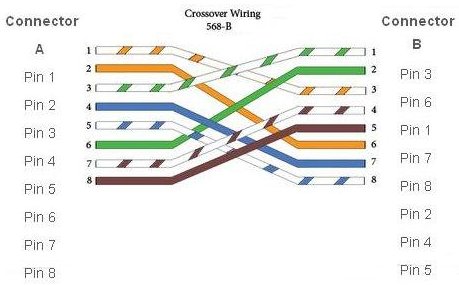
Crossover wiring in T568B
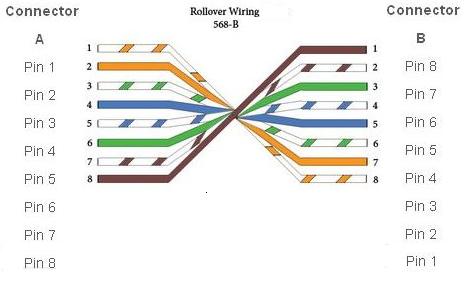
Rollover wiring in T568B
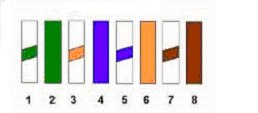
The color coding shown in the effigy corresponds to Environmental impact assessment/TIA 568A standard. For Eia/TIA 568B standard, the dark-green and orange wires are interchanged. By following 568A on either end of the cable, you are preparing direct cable. If one end of the cablevision is 568A and the other end is 568B, the yous are preparing a cross cable.
Direct-through cables: These are primarily used for connecting unlike devices. All wire pairs are in the same order on each end of the cable. A straight-through cablevision is typically used in the following situations:
- Connecting a router to a hub
- Connecting a computer to a swtich
- Connecting a LAN port to a switch, hub, or computer
Crossover cables: These are very similar to straight-through cables, except that they have pairs of wires that crisscross. This allows for ii devices to communicate at the same time. Unlike straight-through cables, we use crossover cables to connect similar devices.
- Connecting a computer to a router
- Connecting a calculator to a computer
- Connecting a router to a router
- Connecting a switch to a switch
- Connecting a hub to a hub
Rollover cables: Rollover cables like other cabling types, got their name from how they are wired. Rollover cables essentially accept ane finish of the cable wired exactly opposite from the other. This essentially "rolls over" the wires. Rollover cables, also called Yost cables, normally connect a device to a router or switch'southward console port. This allows a programmer to make a connection to the router or switch, and program it every bit needed. These types of cables are generally not used very much, so are usually colored differently from other types of cables.
USB Connector:
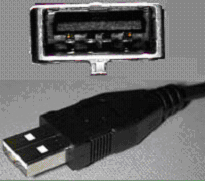
An USB (short for Universal Serial Coach) has the following backdrop:
- High-speed serial connections (ane.5MBytes/sec to 12MBytes/sec)
- Hot-pluggable
- Software designed to recognise USB devices on connexion
- Hubs tin be used to extend the number of USB compatible devices connected to a computer
- It has four pins:
- VCC - Power (+5 volts, upwardly to 500mA)
- D- - Information input to computer
- D+ - Data output from computer
- GND - Footing
USB connectors are of two types, "type A" - apartment type usually used on computer cease; "type B" used on devices.
Ethernet deployment standards:
The distance specification for various media type is every bit given below:
| Standard | Media | Max. Length |
|---|---|---|
| 1000BaseT | Cat 5 UTP, four pair | 100 meters |
| 1000BaseSX | Multi-style fiber cable | 260 meters |
| 1000BaseLX | Single mode fiber cable | three km |
| 100Base-FX | Multi-manner cobweb cable | 2km |
| 10GBase-SR | Multi-mode fiber cable | 26-82m |
| 10GBaseER | Single way fiber cablevision | 40km |
| 10GBaseSW | Multi-mode cobweb cablevision | 200M |
| 10GBaseT | Cat 6a (or higher) | 100m |
Important points to retrieve
The 100BASE-TX specification defines 100Mbps Ethernet manual across Category 5 UTP cable and Type one STP cable at distances up to 100 meters. 100BASE-TX uses two pairs (four wires) in the Ii-Pair wire bundle. Most 100BASE-TX products back up category 5 UTP cabling just. Ethernet 10BaseT is the most widely used network based on star topology.
10Base2 cable uses fifty Ohm, RG-58 cable besides called Thinnet. 10Base2 is a Bus type topology. Bespeak traveling on one direction volition reverberate subsequently reaching the far end, if no termination is provided. Therefore, termination is required at both ends of a 10Base2 Ethernet network.
10Base5 cable uses 50 Ohm, RG-viii, or RG-eleven cable also called Thicknet.
For connecting ii network nodes which are more than than 500m autonomously without any repeater and on a unmarried segment, a 100BaseFX is proper pick. Note that even10Base2 (185m) and 10Base5 (500m) can also reach this distance if more segments are used using repeaters.
Note that the prefix indicates the maximum speed. For example, 100BaseFX has a maximum speed of 100Mbps, and 10Gbase has a maximum speed of 10Gbps.
Gigabit Ethernet conforms to IEEE 802.3z.
One of the disadvantages of 10Base2 Ethernet is that, any cable break at any bespeak on the network may cause breakdown of the unabridged network. 10BaseT Ethernet specifies UTP cabling. UTP cabling uses RJ-45 connectors to connect the cable to the NIC (Network Interface Card).
100 pair cables are used every bit feeder cables for big telephone company installations. 100 pairs of wires are combined in to a large insulated cable for running through the phone installations.
1000BaseT uses cat 5e or better UTP cable. The standard uses iv pairs of wires and support a maximum distance of 100 meters. Supports a maximum speed of 1000Mbps. Note that 100BaseTX uses merely 2 pairs of True cat 5 cablevision.
10Gbase-LW(802.3ae) - supports x km, cablevision type used: Single mode cobweb (SMF), typically used with SONET
10Gbase-EW(802.3ae) - supports xl km, cablevision type used: Unmarried mode cobweb (SMF)
10Base2 tin back up maximum cable length of 185 meters. The specification for Thinnet is RG 58 A/U or RG 58 C/U co-axial cablevision. Thinnet uses BNC connectors along with T connectors required to connect to the BNC female connector on the NIC.
The speeds supported by various cobweb cables types are every bit below:
10Gbase-SR: Supports a max speed of 10Gbps up to 300 meters. It uses multimode fiber, 850nm laser.
10Gbase-ER: Supports a max speed of 10Gbps up to 40 kilometers. It uses single-mode fiber, 1310 nm laser.
10Gbase-SW: Supports a max speed of 10Gbps up to 300m. It uses multimode cobweb.
10Gbase-T: Supports a max speed of 10Gbps up to 100m. It uses Cat 6a (or higher)
10GbaseT uses UTP cabling and connect to networks using Fast Ethernet. The standard supports a maximum distance of 100 m.
1000BaseT: utilizes all 4 pairs of a Category 5 cable.
10BaseT Ethernet: uses RJ-45 connectors at the ends of the UTP cablevision.
10GbaseLR: Supports a max speed of 10Gbps upward to 10 kilometers. It uses single-fashion fiber, 1310nm light amplification by stimulated emission of radiation
FDDI: Supports a max speed of 100Mbps upwardly to 10 kilometers. It uses multi-manner cobweb.
100BaseT (Fast Ethernet) uses IEEE803.2u standard which incorporates CSMA/CD protocol.
10BaseT (this is part of the IEEE 802.3 specification), has a distance limit of approximately 100 meters (328 feet) per segment.
Copper Cable standards: Category 5 straight cable is used to connect a workstation to a switch or a hub in 100BaseTX Ethernet network. A crossover cable is used to connect a hub/switch to some other hub/switch.
You need to employ crossover cablevision to connect two network Hubs, and straight cables to connect workstations to the Hub. A crossover cablevision directly connects two compatible network devices to each other over Ethernet. Ethernet crossover cables are commonly used when networking two devices in situations where a network router, switch or hub is not nowadays. Compared to standard Ethernet cables, the internal wiring of Ethernet crossover cables reverses the transmit and receive signals.
Termination points:
Patch panel: A patch panel is a console that contains multiple cable connections. The dorsum of the panel has cabling that runs to disparate equipment or networks. The forepart of the patch panel allows easy admission to connect the different equipment (or networks) through the use of short patch cables. I common case of this concept was earlier automatic phone switching became widespread; early telephone operators would connect callers to their intended parties manually past plugging in a cable on the switchboard.
Media types:
STP stands for Shielded Twisted Pair and UTP stands for Unshielded Twisted Pair.
Shielded Twisted Pair (STP): STP cables reduce electrical racket and electromagnetic radiations. In other words, they help to go on the betoken steady, and reduce interference with other devices. Given beneath is a diagram showing a typical shielded twisted pair cable
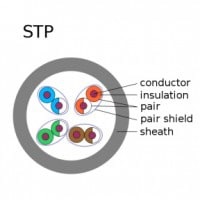
Unshielded Twisted Pair (UTP): UTP cables practice not accept shielding to reduce interference. They are designed to cancel electromagnetic interference with the style the pairs are twisted inside the cablevision. Unshielded twisted cables are most widely used for office LANs, though recently wireless LANs are more widely used. Unshielded cables are lightweight, thin and flexible. They are also versatile and inexpensive. A typical UTP cable cantankerous section is shown in the figure below:
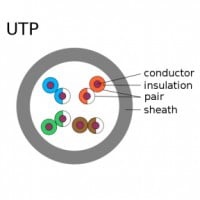
Comparing betwixt STP and UDP
i. Physical: The only difference between the STP and UTP cable is the additional shielding material used in STP cables. The shielding covers the full length of the cable and protects it from any external interference.
2. Cost: Due to the additional fabric used in a STP cablevision, information technology costs more than the UTP cablevision
3. Considerations: While using STP cablevision volition yield maximum bandwidth despite external conditions, the shielding makes the cablevision heavier and more difficult to bend.
4. Use: UTP cablevision typically is used in homes and offices. Some large businesses also apply the cable considering information technology is cheaper. Large companies that crave maximum bandwidth typically utilize STP cable. STP cable is used outside to better deal with the elements and equipment that may dethrone bandwidth quality.
Previous Contents Next
Which Of The Following Connector Types Would You Most Likely Use To Connect To A T1 Wan Service?,
Source: https://www.examguides.com/Networkplus/network-plus-9.htm
Posted by: owensrigand73.blogspot.com


0 Response to "Which Of The Following Connector Types Would You Most Likely Use To Connect To A T1 Wan Service?"
Post a Comment